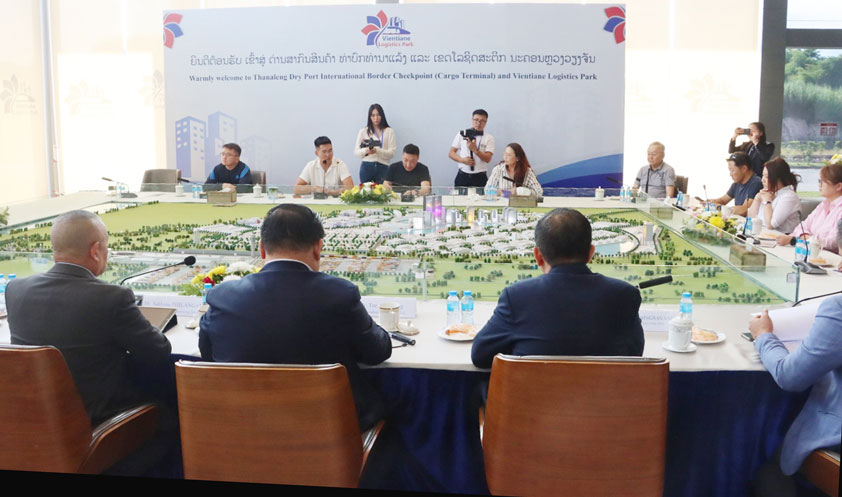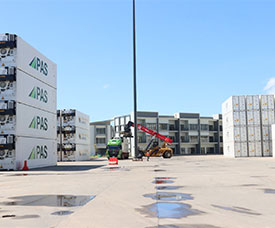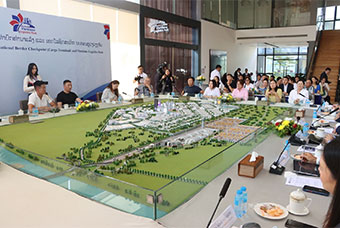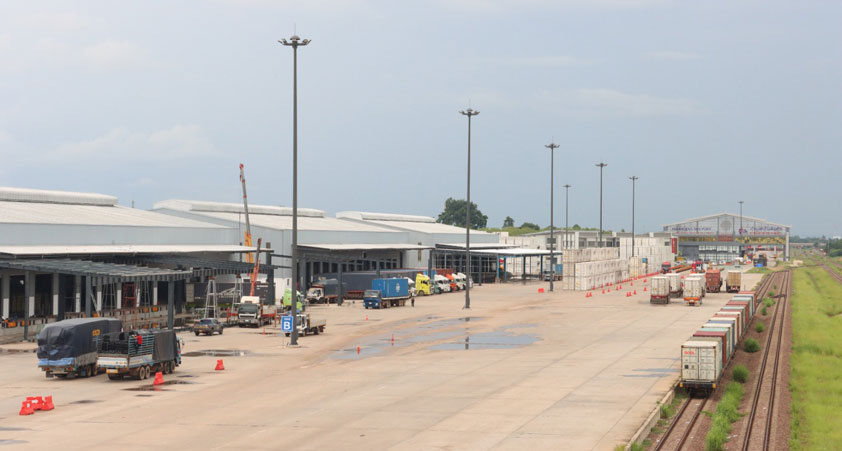 |
Mongolian business representatives (left) are briefed about the operations of the Thanaleng Dry Port and Vientiane Logistics Park. |
Visiting the Thanaleng Dry Port: Mongolian business executives seek opportunities
Mongolian business executives are seeking business opportunities through logistics links via Laos as the Southeast Asian country is becoming a logistics connector for the region.
The Laos-China railway, and the Thanaleng Dry Port and its associated Vientiane Logistics Park that became operational in December 2021, have linked Southeast Asia all the way to China, Mongolia and Europe.
“Goods have already passed through the Vientiane Logistics Park to China, Mongolia and reached Russia,” Vice President of Vientiane Logistics Park Co., Ltd., Tee Chee Seng, told Mongolian business executives.
The Mongolian business delegation visited the dry port, Laos’ integrated logistics connector, on Monday (November 6). They accompanied Mongolian President Khurelsukh Ukhnaa on a two-day state visit to Laos on November 5-6.
From Russia, the rail network reaches Germany.
“With the railway, we are well connected,” Mr Tee Chee Seng said.
From the dry port in Vientiane where the Laos-China and Laos-Thailand railways converge, the trade route links to Thailand and the rest of Asean (Association of Southeast Asian Nations).
“We are a gateway for Asean and Europe,” he said, expressing the hope that Lao and Mongolian entrepreneurs will engage more closely with one another and the rest of the region.
Mr Tee Chee Seng suggested that business operators in Laos and Mongolia lobby the governments of the two landlocked countries to offer reciprocal zero tariffs in order to bolster trade and investment.
The suggestion came as the leaders of the two countries agreed to strengthen cooperation in economic, trade, investment and tourism affairs.
On Monday, Laos and Mongolia signed seven documents aimed at boosting cooperation following talks between President Thongloun Sisoulith and his Mongolian counterpart Khurelsukh Ukhnaa.
Meeting President Ukhnaa, Prime Minister Sonexay Siphandone asked the Mongolian leader to strengthen trade and investment cooperation by assisting with arrangements for the private sectors of the two countries to meet and discuss possible partnerships.
Mr Tee Chee Seng told the guests that the Lao government has promotional policies in place that allow foreign investors to own business operations outright, to partner with local businesses, or to partner with the government.
The developer of the dry port is also setting up a logistics park to welcome foreign investment. The park includes an export processing zone, logistics park, free trade zone, and technology and halal hub.
Incoming investors will enjoy a number of incentives as specified by Laos’ laws and regulations, including a corporate tax holiday of 8-16 years, zero customs duty, lower Value-Added Tax and more, with cheap electricity being an added bonus.
To better facilitate the shipment of farm produce, the dry port’s developer is working with Chinese authorities to build a sanitary and phytosanitary (SPS) centre at the logistics park to provide a one-stop certification service in Laos that will enable certified goods to enter Chinese markets.
“Goods inspected here will no longer need to undergo another inspection at the Chinese border,” Thanaleng Dry Port’s Managing Director Sakhone Philangam said.
Thanks to speedy and cost-effective services provided by the Thanaleng Dry Port International Border Checkpoint (Cargo Terminal) and railway, more and more goods have been shifted via the trade route.
Last year, more than 50,000 containers passed through the dry port, averaging more than 4,000 containers a month.
In the first six months of this year, the number soared to more than 7,000 containers a month and is expected to reach 70,000 containers in total, equivalent to 3 million tonnes for the whole year. The containers are destined for countries such as Thailand, Vietnam, Cambodia, Myanmar, Malaysia, Singapore, China and Russia.
Mr Sakhone noted that the cold chain service provided by the dry port could benefit Mongolia, which has the potential to produce meat for export to Asean countries.
The director said he had visited Mongolia to discuss Laos’ logistics link services with Mongolia’s Ministry of Foreign Affairs.
Financed solely by a Lao investor, the US$727 million dry port and Vientiane Logistics Park project is part of the Lao government’s strategy to transform the country into a land-link country.
With Laos now becoming a land-link country and a trade gateway for Asean, China and Europe, Mr Tee Chee Seng said the country is well positioned for manufacturing and export to other regions connected.
Through cost-effective transport connectivity coupled with incentives offered by the Lao government, manufacturers in Laos also enjoy privileged access to markets in countries whose governments have waived or reduced import tariffs on made-in-Laos products.
More than 30 countries including Australia, Canada, members of the European Union (EU 28), Japan, New Zealand, Norway, Russia, Switzerland and Turkiye have extended such privileges to Laos.
“Invest here and you can export [products] to Thailand, Cambodia, other Asean countries and even back to Mongolia,” Mr Tee Chee Seng said.
By Advertorial
(Latest Update November 8, 2023)
|





